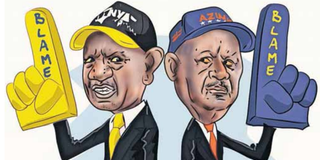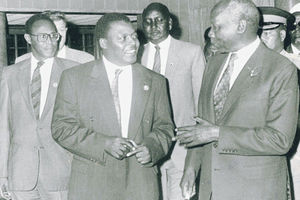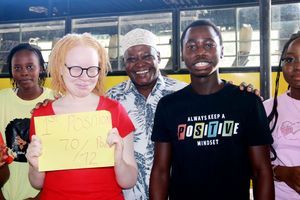Premium
Breaking the impasse: How Ruto, Raila came to read from same script

As the situation escalates, so does the grandstanding between Ruto and Raila, and their supporters.
When he presided over the 2022 Madaraka Day celebrations on June 1 – his last public national day function as President – Uhuru Kenyatta defied protocol by denying his then deputy, William Ruto, an opportunity to address the nation.
It was an eerie signal of the acrimony that would characterise the approaching presidential contest, then just 68 days away, and Uhuru’s own political succession.
But seizing the opportunity, an optimistic Kericho Senator Aaron Cheruiyot posted a picture of Ruto and Raila Odinga shaking hands at the event, with a rather cheeky caption: “The Nilotes size each other up. The Nilotes derby on August 9, 2022, will be like no other. Good thing, it will be home either way.”
Although accused of perpetuating tribal politics, the comments were made purely in jest, with the assumption that the polls would be a friendly contest between members of the same ethno-linguistic bloc. How wrong he was! Like all other derbies, especially in football, there is never a conclusive end to such rivalry, even after the final whistle.
And the central role played by Uhuru – who opted to make public his preferred side – has further poisoned and complicated the Ruto-Raila game. Despite Kenyatta respecting the final outcome and handing over the instruments of power to Ruto, the standoff between the new President and Odinga still holds. It is the source of ongoing mass action declared by the opposition Azimio la Umoja-One Kenya coalition.
As the situation escalates, so does the grandstanding between Ruto and Raila, and their supporters. Those allied to the United Democratic Alliance leader have declared that this time round “the old man must be taught a lesson”. Raila’s backers, on the other hand, have vowed to “push some sense into the hard-headed Ruto”.
Only a fortnight ago, the President ruled out the possibility of caving into pressure to engage his rival through what he refers to as “unconstitutional means”. He said, however, that he was ready to engage with any leader provided it is within the confines of the Constitution.
The Azimio leader has similarly rubbished claims by Ruto-allied politicians that his end game is to “enter government through the backdoor”.
The 77-year-old politician maintains he is only interested in pushing the case of poor Kenyans being subjected to high costs of living owing to government’s “departure from its campaign promises”. The current hostilities have attracted the interest of many, including the African Union Commission.
On Tuesday, the AU Commission chairperson Moussa Faki asked President Ruto and Raila to address their differences. Faki is fairly well-versed with the issues at hand and is known to the two protagonists. The AU has since 2007 played a crucial role in calming Kenya’s political and electoral heat.
Following the 2007/8 post-election violence triggered by the highly disputed and discredited presidential poll, former Ghanaian President John Kuffor and later former United Nations Secretary General Dr Kofi Annan rushed in to rescue the country from bloodbath.
Besides overseeing a political settlement that created a Grand Coalition Government, with Mwai Kibaki as President and Raila as Prime Minister, the late UN chief also set up two key commissions – the Independent Review Committee and the Commission of Inquiry into the Post-Election Violence – led by retired South African judge Johann Kriegler and Kenyan judge Philip Waki.
The Kriegler Commission made a raft of proposals to improve the electoral process, most of which were implemented. Also pushing for a truce are the National Cohesion and Integration Commission (NCIC) and a group of religious leaders.
The NCIC Chairperson, Dr Samuel Kobia, wanted an immediate stop to the demonstrations and counterdemonstrations and adoption of dialogue instead. However, the dialogue route is not acceptable to all. Those already in government, for instance, fear that dialogue could precipitate a scenario where some could be elbowed out to accommodate the opposition leader and his lieutenants.
There is already a precedent to this effect: After he was controversially declared the victor in the December 2007 presidential poll, Kibaki appointed a 17-member Cabinet on January 8, 2008, that included Orange Democratic Movement-Kenya leader Kalonzo Musyoka as Vice-President and Ford-Kenya’s Moses Wetang’ula as Foreign Affairs Minister.
The route of a Grand Coalition Government is one of the avenues that can be used to calm political temperatures, even though Ruto and Raila have separately expressed disinterest in a symbolic handshake, let alone forming a government of national unity. In any case, and unlike in 2007, petition mechanisms were put in place following the establishment of the Supreme Court – an avenue that the opposition has already exhausted.
The political class can also borrow from the Inter-Parties Parliamentary Group (IPPG) created in September 1997. Then, parliament adopted constitutional reforms intended to avert bloodshed ahead of elections expected to take place in December that year.
Spearheaded by the then MP for Fafi, Jillo Falana of the ruling Kanu party, the IPPG sought to improve polls management by including representatives of political parties in the then Electoral Commission of Kenya. Other changes provided for the repeal of laws that gave room for detention without trial, as well as equal access to State media by the opposition and the ruling party.
But claiming that today the government has gone to bed with virtually all other arms of government, constitutional lawyer Paul Mwangi argues that picketing is the only available option for the people at the moment. Mwangi, who is also Raila’s lawyer, states that the people have taken back their sovereign rights donated to their elected leaders “because they have no other plausible alternative to have their concerns addressed”
The protests, in the viewpoint of the opposition, are occasioned by President Ruto’s inability to meet campaign promises, including lowering the cost of living. Another avenue for recourse is the Building Bridges Initiative (BBI).
Projected as a tool to promote inclusivity and national cohesion, BBI aimed to cure the winner-takes-it all rule in elections.





